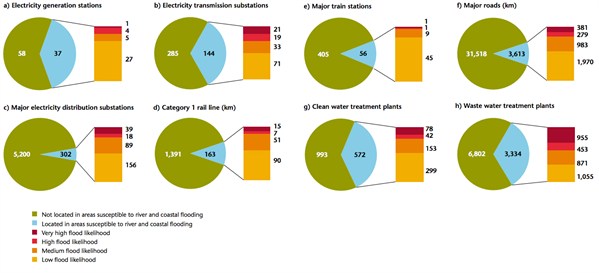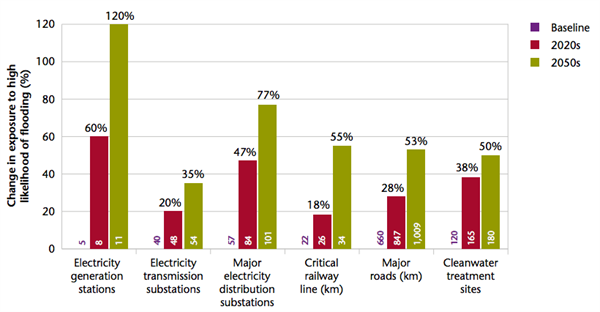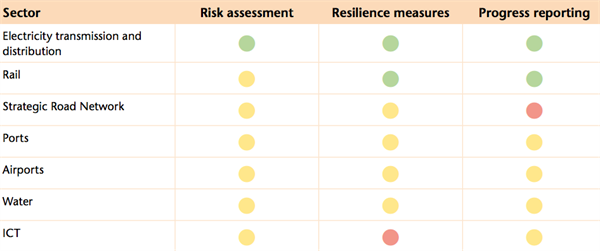Simon Evans
09.07.2014 | 12:01amWhen things go wrong with our critical infrastructure, it makes national news. Cornwall was cut off from the rail network when the line collapsed into the sea at Dawlish during last winter’s storms. And Gatwick airport closed on Christmas Eve when an electricity sub-station was flooded.
We all rely on things like drinking water treatment works, broadband connections, trunk roads, rail lines, power stations, airports and the electricity network to go about our daily lives.
So we should all be worried that efforts to make this infrastructure more resilient to flooding, drought or coastal erosion are patchy. That’s according to a new report from the government’s Committee on Climate Change (CCC).
It says the task is getting harder too, as climate change raises sea levels and changes rainfall patterns, although uncertainty about the UK’s future climate makes it hard to know exactly how much.
The CCC says the number of the most important national infrastructure assets at high risk of flooding, for instance, will increase by at least 50 per cent by the 2050s because of climate change. Other climate risks are also expected to increase.
We’ve taken a look at the risks our infrastructure faces and efforts to boost resilience in different sectors.
Risks, multiplied
Climate change has already increased some risks compared to historical norms. Sea levels rose by 16 centimetres during the 20th century making tidal flooding and coastal erosion more likely. And the chance of very wet winters in southern England has increased by 25 per cent because of already-emitted carbon, according to preliminary results from the University of Oxford.
That means a substantial proportion of England’s critical infrastructure is facing some level of flood risk today, as the chart below shows. The number of assets at risk is shown in blue. Those numbers are broken down into different levels of flood risk in shades of red and orange.
Source: CCC Adaptation Sub-Committee progress report 2014
Assets at very high flood risk have a 10 per cent risk (1-in-10) in a given year. High flood risk means greater than a 1-in-30 chance of flooding in any given year. Medium flood risk means less than 1-in-30 but more than 1-in-100. Low risk means less than 1-in-100 chance of flooding.
The figures in the chart are calculated accounting for community-level flood defences maintained by government agencies. But they don’t include protection provided by defences installed on site, so they are a worst-case estimate of the levels of risk.
Even so, you might be surprised to know that 700,000 homes and businesses, three drinking water treatment works and one hospital all get their electricity from the 57 major substations that are at high or very high risk of flooding.
These vulnerabilities will be increased by climate change. Instead of 57 major substations at risk today, there will be 84 at risk in the 2020s (red bars, below) and 101 in the 2050s (green bars).
Source: CCC Adaptation Sub-Committee progress report 2014
Other critical infrastructure also faces increased flood risk. Over 1,000 kilometres of major roads would face 1-in-30 year flood risks by the 2050s, for instance.
Top marks for electric sparks
Luckily for those 700,000 homes and three water treatment works the CCC has awarded the electricity sector top marks for its efforts to adapt to climate change risks. A proper response involves having carried out an assessment of climate risks, considered the cost of adaptation resilience measures and reported publicly on plans to implement them.
The CCC’s head of adaptation Lord Krebs said the electricity sector has ticked all of those boxes. “They’re well on to the case,” he told journalists before the report launch. Network Rail has gone a long part of the way, said Krebs, and is taking an increasingly long-term view of managing its assets. But its investment plans don’t properly account for the ways climate will change in future.
The CCC has given scores for progress on the three areas of adaptation work among the different infrastructure sectors, using a traffic light system. The scorecard isn’t exactly glowing. Here’s how it looks.
Source: CCC Adaptation Sub-Committee progress report 2014
Roads
The Highways Agency has assessed the climate change risks facing motorways and trunk roads but has not produced detailed plans to deal with them, the CCC says. No information is publicly available on planned spending to boost resilience and there has been no reporting on progress.
Water
Water regulator Ofwat has asked water companies to make plans to address flood risk under their next spending round covering 2015-2020. But it hasn’t asked them to look at subsidence or coastal erosion. The CCC says it’s hard to tell how resilient the water sector is to climate risks. It warns that Ofwat has no plan to systematically keep tabs on performance.
Airports
Most airports have checked their flood risk but the CCC says they haven’t set themselves clear deadlines to actually reduce the risks they identified. The floods that closed Gatwick last Christmas show why this can be a problem.
The closure might have been avoided if Gatwick had implemented flood protection measures that it had itself identified in its assessment of climate change risks, the CCC says. In February the airport’s operators promised to spend an extra £30 million to bring flood protection up to scratch.
Telecommunications
The CCC has long had concerns about adaptation in the telecomms sector. A government review of telecomms found the flood risk was low. But it isn’t clear if this assessment included the future effects of climate change, the CCC says.
The committee also couldn’t find any information on what the sector is doing to adapt to future risk. A little more information should become available this autumn, however.
Reporting progress to government
A handful of telecomms firms have agreed to send the government reports on their adaptation plans, as have most water companies, power firms and airports.
Under powers contained in the 2008 Climate Change Act, government can invite or require critical infrastructure providers to produce reports on how they plan to boost their resilience to climate risk. A first round of mandatory reporting finished in 2011. The second round is entirely voluntary, even though Lord Krebs previously warned government to “consider the limitations” of voluntary reporting.
The CCC’s report says government needs to find ways to improve resilience planning by critical infrastructure providers. But the committee seems reluctant to tell government what to do. For instance Carbon Brief asked Lord Krebs if the adaptation reporting power requirements should be mandatory. “We leave that open,” he said.
The CCC is also concerned about interdependencies between different infrastructure types. That’s the technician who can’t get to work because the road is flooded, for instance.
It says that infrastructure regulators should agree a consistent approach to adaptation within their sectors. The regulators of the energy, water, rail and telecoms sectors are due to come together to review resilience next year.
Regulators should insist that operators have adaptation plans in place, with clear targets and business cases for investment in resilience, the CCC says. It also thinks that there should be a consistent review process to see if operators are doing well on resilience or not. The systems of incentives and penalties in each market might need tweaking to encourage resilience.
This year’s adaptation report from the CCC looked at infrastructure, flooding, health and business risks. Next year the CCC will deliver an official scorecard on the whole nation’s adaptation progress, bringing together these topics with its earlier work on agriculture, natural ecosystems, wildlife and more.




